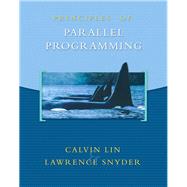
Note: Supplemental materials are not guaranteed with Rental or Used book purchases.
Purchase Benefits
Looking to rent a book? Rent Principles of Parallel Programming [ISBN: 9780321487902] for the semester, quarter, and short term or search our site for other textbooks by Lin, Calvin; Snyder, Larry. Renting a textbook can save you up to 90% from the cost of buying.
| Introduction: Parallelism = Opportunities + Challenges | |
| The Power and Potential of Parallelism Examining Sequential and Parallel Programs | |
| A Paradigm Shift Parallelism | |
| Using Multiple Instruction Streams | |
| The Goals: Scalable Performance and Portability | |
| Summary | |
| Historical | |
| Context | |
| Exercises | |
| Parallel Computers And Their Model Balancing Machine | |
| Specifics with Portability | |
| A Look at Five Parallel Computers | |
| The RAM: An Abstraction of a Sequential Computer | |
| The PRAM: A Parallel Computer Model | |
| The CTA: A Practical Parallel Computer Model Memory Reference | |
| Mechanisms A Closer Look at Communication | |
| Applying the CTA Model | |
| Summary | |
| Historical Perspective | |
| Exercises | |
| Reasoning about Performance | |
| Introduction | |
| Motivation and Some Basic Concepts | |
| Sources of Performance Loss Parallel Structure | |
| Reasoning about Performance | |
| Performance Trade-Offs Measuring | |
| Performance What should we measure? | |
| Summary | |
| Historical Perspective | |
| Exercises | |
| First Steps Towards Parallel | |
| Programming Task and Data Parallelism Peril-L Count 3s | |
| Example Conceptualizing Parallelism Alphabetizing | |
| Example Comparison of Three Solutions | |
| Summary | |
| Historical Perspective | |
| Exercises | |
| Scalable Algorithmic Techniques | |
| The Inevitability of Trees Blocks of Independent | |
| Computation Schwartzrsquo; Algorithm Assigning | |
| Work To Processes Statically Assigning | |
| Work to Processes Dynamically | |
| The Reduce & Scan Abstractions Trees | |
| Summary | |
| Historical Context | |
| Exercises | |
| Programming with Threads POSIX Threads | |
| Thread Creation and Destruction Mutual Exclusion | |
| Synchronization Safety Issues | |
| Performance Issues | |
| Open MP The Count 3s | |
| Example Semantic Limitations on Reduction Thread | |
| Behavior and Interaction Sections | |
| Summary of OpenMP Java Threads | |
| Summary | |
| Historical Perspectives | |
| Exercises | |
| Local View Programming Languages MPI: The Message Passing Interface | |
| Getting Started Safety Issues | |
| Performance Issues | |
| Co-Array Fortran Unified Parallel C Titanium | |
| Summary | |
| Exercises | |
| Global View Programming Languages | |
| The Z-level Programming Language | |
| Basic Concepts of ZPL Life, An Example Design Principles | |
| Manipulating Arrays Of Different Ranks | |
| Reordering Data With Remap Parallel Execution of ZPL Performance Model | |
| Summary NESL | |
| Historical Context | |
| Exercises | |
| Assessing Our Knowledge | |
| Introduction | |
| Evaluating Existing Approaches Lessons for the Future | |
| Summary | |
| Historical Perspectives | |
| Exercises | |
| Future Directions in Parallel Programming | |
| Attached Processors Grid Computing Transactional Memory | |
| Summary | |
| Exercises | |
| Capstone Project: Designing a Parallel Program | |
| Introduction | |
| Motivation Getting Started | |
| Summary | |
| Historical Perspective | |
| Exercises | |
| More Advanced Concepts | |
| Table of Contents provided by Publisher. All Rights Reserved. |
The New copy of this book will include any supplemental materials advertised. Please check the title of the book to determine if it should include any access cards, study guides, lab manuals, CDs, etc.
The Used, Rental and eBook copies of this book are not guaranteed to include any supplemental materials. Typically, only the book itself is included. This is true even if the title states it includes any access cards, study guides, lab manuals, CDs, etc.